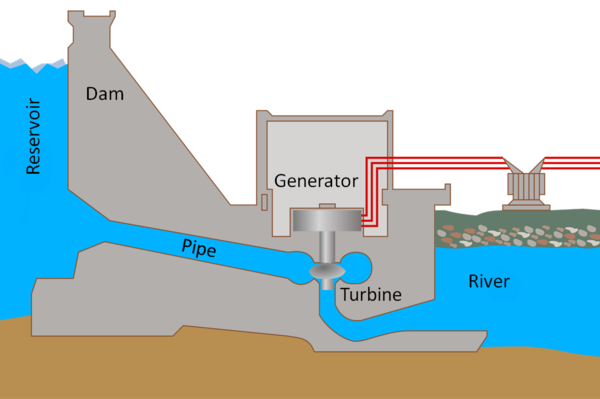Difference between revisions of "Hydroelectric"
| Line 1: | Line 1: | ||
==Key Stage 3== | ==Key Stage 3== | ||
| + | ===Meaning=== | ||
| + | '''Hydroelectricity''' is an [[Energy Resource|energy resource]] that uses the water flowing in rivers to generate electricity. | ||
| + | |||
| + | ===About Hydroelectricity=== | ||
| + | : '''Hydroelectricity''' is a [[Renewable Energy Resource|renewable energy resource]]. | ||
| + | : '''Hydroelectricity''' has [[energy]] in the [[Gravitational Potential Energy Store|gravitational potential energy store]] of water that is flowing downhill. | ||
| + | |||
| + | ===Power=== | ||
| + | '''Hydroelectricity''' can be used to generate [[electricity]]. | ||
| + | {| class="wikitable" | ||
| + | |- | ||
| + | |[[File:HydroelectricDamDiagram.png|center|600px]] | ||
| + | |- | ||
| + | | style="height:20px; width:200px; text-align:center;" |A [[diagram]] of a [[hydroelectric]] dam. | ||
| + | |} | ||
| + | : 1. Water flowing down a river is held back by a dam making a large reservoir. | ||
| + | : 2. Some water is allowed through pipes to flow downhill. | ||
| + | : 3. This water turns a turbine as it falls. | ||
| + | : 4. The turbine causes a generator to spin. | ||
| + | : 5. The generator makes an electrical current. | ||
| + | |||
| + | ====Advantages==== | ||
| + | *Reliable source as it is built in places that do not suffer drought. | ||
| + | *Power provided can change at a moments notice by allowing more water through the turbines. | ||
| + | *Low running costs and no fuel cost. | ||
| + | |||
| + | ====Disadvantages==== | ||
| + | *Expensive to build. | ||
| + | *Require the flooding of a large area of land. | ||
| + | *Destroys habitat of some creatures. | ||
| + | *Blocks the migration of some river species. | ||
| + | *Can only be built in certain locations. | ||
| + | |||
| + | ==Key Stage 4== | ||
| + | {{#ev:youtube|https://www.youtube.com/watch?v=Qef-f2KobIY}} | ||
===Meaning=== | ===Meaning=== | ||
'''Hydroelectricity''' is an [[Energy Resource|energy resource]] that uses the water flowing in rivers to generate electricity. | '''Hydroelectricity''' is an [[Energy Resource|energy resource]] that uses the water flowing in rivers to generate electricity. | ||
Revision as of 16:26, 13 April 2019
Contents
Key Stage 3
Meaning
Hydroelectricity is an energy resource that uses the water flowing in rivers to generate electricity.
About Hydroelectricity
- Hydroelectricity is a renewable energy resource.
- Hydroelectricity has energy in the gravitational potential energy store of water that is flowing downhill.
Power
Hydroelectricity can be used to generate electricity.
| A diagram of a hydroelectric dam. |
- 1. Water flowing down a river is held back by a dam making a large reservoir.
- 2. Some water is allowed through pipes to flow downhill.
- 3. This water turns a turbine as it falls.
- 4. The turbine causes a generator to spin.
- 5. The generator makes an electrical current.
Advantages
- Reliable source as it is built in places that do not suffer drought.
- Power provided can change at a moments notice by allowing more water through the turbines.
- Low running costs and no fuel cost.
Disadvantages
- Expensive to build.
- Require the flooding of a large area of land.
- Destroys habitat of some creatures.
- Blocks the migration of some river species.
- Can only be built in certain locations.
Key Stage 4
Meaning
Hydroelectricity is an energy resource that uses the water flowing in rivers to generate electricity.
About Hydroelectricity
- Hydroelectricity is a renewable energy resource.
- Hydroelectricity has energy in the gravitational potential energy store of water that is flowing downhill.
Power
Hydroelectricity can be used to generate electricity.
| A diagram of a hydroelectric dam. |
- 1. Water flowing down a river is held back by a dam making a large reservoir.
- 2. Some water is allowed through pipes to flow downhill.
- 3. This water turns a turbine as it falls.
- 4. The turbine causes a generator to spin.
- 5. The generator makes an electrical current.
Advantages
- Reliable source as it is built in places that do not suffer drought.
- Power provided can change at a moments notice by allowing more water through the turbines.
- Low running costs and no fuel cost.
Disadvantages
- Expensive to build.
- Require the flooding of a large area of land.
- Destroys habitat of some creatures.
- Blocks the migration of some river species.
- Can only be built in certain locations.
